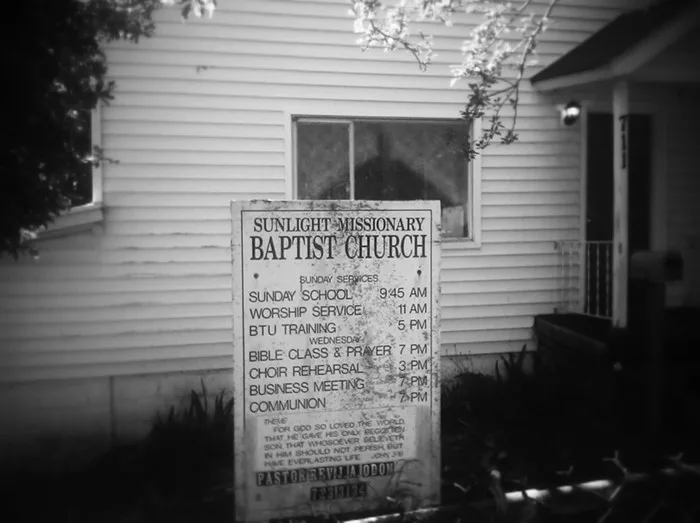
This has been on my mind since reading Gene Balk’s recent post, “Seattle is the least-religious large metro area in the US.” Our city might have a high percentage of people who “never attend church or religious services” because post-gentrification (Seattle is now gentrified) Blacks make up only “6% of the total population.” Balk points out that, on a national level, a whooping 65% of Black Americans are in church on the regular. They are the most religious people in the US.
Meanwhile, white people are at the bottom of this god-loving list (46%). And yet their churchgoers have more political power than any other group in the country. Without them, Donald Trump would not be running for president this year. Without them, the Senate would be more progressive. Without them, Roe v. Wade would still be the law of the land. The political over-representation of white churchgoers is so considerable that it’s hard to call the US a democracy.
Get ready, because this is my post’s point of departure.
This is quite a video. Every so often you just need to zoom out and reflect on how insane everything has become. pic.twitter.com/pBTmNECutN
— Brian Klaas (@brianklaas) March 7, 2024
We can laugh all we want at the seemingly incredible resilience of Donald Trump (beats walking on water any day), but for people of color it only makes crystal clear how little this society values our votes. And as the number of white American churchgoers falls, their overrepresentation at the ballot will only increase. In fact, this is exactly why the country is teetering above the abyss of full-blown totalitarianism.
The inflation of white churchgoing voters might not be enough. It might still be overwhelmed by the underrepresented, such as cosmopolitan whites, Black churchgoers, and so on. But it has led us to an election that’s not a contest between the two best candidates but rather a contest between the destruction of what remains of American democracy and the maintenance of a center-left that can’t be distinguished from what was once the center-right. For sure, the center-left/right is devoted to full employment, the protection of Social Security, and unionization, but it’s also devoted to the destruction of capital by military expenditure and wars.
And this gets me to a point that needs repeating: one of the three key functions of the capitalist state is to remove capital from the economy. This is called devaluation theory. It’s almost unknown in the English-speaking world because its leading theorist, Paul Boccara, is virtually unknown outside of France and its language. But elements of the idea can be found in Marx’s Grundrisse and Rosa “Queen of Underconsumptionists” Luxemburg’s Accumulation of Capital. The geographer and social theorist David Harvey devoted a chapter to the theory of devaluation and a few passages to Boccara in his masterpiece, The Limits of Capital.
Harvey:
Boccara sees the twin principles of overaccumulation and devaluation as the key to understanding the structural transformations that capitalism has experienced in the course of its history. He suggests that the only viable long-run response to overaccumulation is to accomplish ‘structural devaluations’, which permit the tendency towards a falling rate of profit to be countered by keeping more and more capital in circulation in both relatively and absolutely devalued states.
But if one does not appreciate the state’s devaluation function, then something like the ongoing destruction of Gaza makes little economic sense. Each bomb that explodes there, as with each bomb that explodes in Ukraine, removes capital from an economic system that has too much of it all of the time and is condemned to accumulating it at a faster and faster rate.
The difference between mainstream Dems and the GOP’s far-right (it no longer has center) is the latter prefers military (and a militarized police) to do almost all of the devaluation. Biden represents a political position that gives social services and social investments (building bridges and other infrastructural projects) some role to play in this devaluation, this destruction, or this costly and permanent fixing of capital. But the question that must be asked is this: What would an economy that cleared excess, ever-increasing, and crisis-prone capital from the system by only social investments look like? Would it work? Yes, it would. And we have the evidence.
Before 1937, FDR’s massive social investments actually worked. The economy finally began recovering from the crash of 1929. But the business community rebelled. They demanded and received deep cuts in federal expenditure. This period in economic history (misery) is called the Roosevelt Recession. The consequence? The state was left with bombs/bullets/boots/blood/tanks/submarines to remove capital from the system. We have been here ever since.
At least five Palestinians have been killed, and several others reportedly injured after parachutes dropping aid packages over Gaza failed to open and fell on people waiting to collect the aid ⤵️ pic.twitter.com/Kj1vqVGBzu
— Al Jazeera English (@AJEnglish) March 8, 2024

